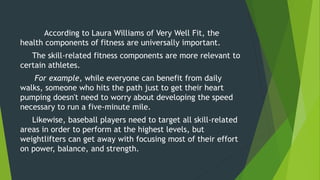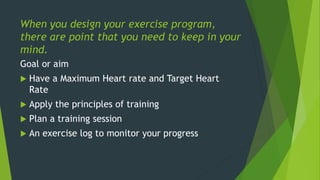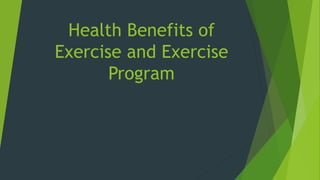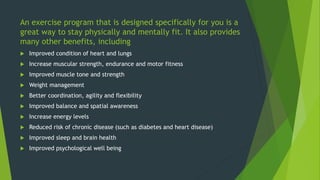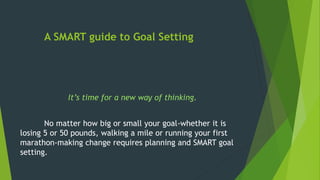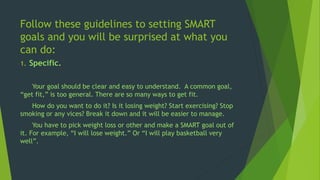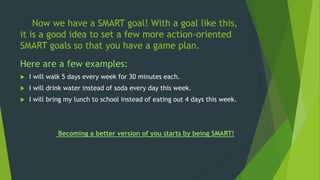Understanding and creating an exercise program
- 1. Understanding and Creating an Exercise Program
- 2. You already know that benefits come when you prioritize physical fitness. The trick is understanding what, exactly, "fitness" is and how you can go about achieving it. The five components of fitness are: Body composition Cardiovascular endurance Flexibility Muscular endurance Muscular strength
- 3. Creating a fitness plan that incorporates each of these elements can help ensure that you get the most health benefits from your routine. And now that you are done with your Physical Fitness Test, you can now identify your weakness in each components, Right? You can now create your own routine based on your capacity.
- 4. For instance, you need cardiovascular endurance and flexibility to play tennis. But to become good at tennis, you have to work on agility, power, speed, and hand-eye coordination. It's this focus on activity-related skills that differentiate two distinct areas of fitness development. The Six (6) skill related fitness components are: Agility Balance Coordination Power Reaction time Speed
- 5. According to Laura Williams of Very Well Fit, the health components of fitness are universally important. The skill-related fitness components are more relevant to certain athletes. For example, while everyone can benefit from daily walks, someone who hits the path just to get their heart pumping doesn't need to worry about developing the speed necessary to run a five-minute mile. Likewise, baseball players need to target all skill-related areas in order to perform at the highest levels, but weightlifters can get away with focusing most of their effort on power, balance, and strength.
- 6. Exercise program It is a planned activity detailing a range of physical exercises and the amount of time each exercise should be performed where it is typically tailored to an individual needs. With this module you will be doing a gradual activity to meet what you expect which is to become… A fit person is able to perform schoolwork, meet home responsibilities, and still have enough energy to enjoy sport and other leisure activities. A fit person can respond effectively to normal life situations, such as raking leaves at home, stocking shelves at a part- time job (if you have) and marching in the band at school. A fit person can also respond to emergency situations - for example, by running to get help or aiding a friend in distress.
- 7. When you design your exercise program, there are point that you need to keep in your mind. Goal or aim Have a Maximum Heart rate and Target Heart Rate Apply the principles of training Plan a training session An exercise log to monitor your progress
- 8. Health Benefits of Exercise and Exercise Program
- 9. An exercise program that is designed specifically for you is a great way to stay physically and mentally fit. It also provides many other benefits, including Improved condition of heart and lungs Increase muscular strength, endurance and motor fitness Improved muscle tone and strength Weight management Better coordination, agility and flexibility Improved balance and spatial awareness Increase energy levels Reduced risk of chronic disease (such as diabetes and heart disease) Improved sleep and brain health Improved psychological well being
- 10. A SMART guide to Goal Setting It’s time for a new way of thinking. No matter how big or small your goal-whether it is losing 5 or 50 pounds, walking a mile or running your first marathon-making change requires planning and SMART goal setting.
- 11. Follow these guidelines to setting SMART goals and you will be surprised at what you can do: 1. Specific. Your goal should be clear and easy to understand. A common goal, “get fit,” is too general. There are so many ways to get fit. How do you want to do it? Is it losing weight? Start exercising? Stop smoking or any vices? Break it down and it will be easier to manage. You have to pick weight loss or other and make a SMART goal out of it. For example, “I will lose weight.” Or “I will play basketball very well”.
- 12. 2. Measurable A goal to “lose weight” is not enough. How will you track your progress and how you will know when you have reached your goal? Making your goal measurable means adding a number.
- 13. 3. Attainable Before you can add a number, you have to know how high or low you want to go. It is good to ‘shoot for the stars’, but do not be too extreme. Likewise, a goal that is too easy is also not very motivating. Only you know your limits. Let us take our goal above. What percentage is attainable for you? Research suggests that a 5-10% weight loss is attainable for most overweight people A measurable, attainable goal could be, “I will lose 7% of my body weight.”
- 14. 4. Relevant Set goals that are important to where you are in your life right now. Do not set a goal that someone else is pressuring you to attain-that is not very motivating. Examine our goal so far. Does it seem relevant to you? If so, let us keep going. If you are not concerned about weight loss or other this is not a good time in your life to focus on that, choose something that is motivating to you.
- 15. 5. Time-bound Include an end-point. Knowing that you have a deadline motivates you to get started.
- 16. Now we have a SMART goal! With a goal like this, it is a good idea to set a few more action-oriented SMART goals so that you have a game plan. Here are a few examples: I will walk 5 days every week for 30 minutes each. I will drink water instead of soda every day this week. I will bring my lunch to school instead of eating out 4 days this week. Becoming a better version of you starts by being SMART!
- 17. Thank you!




